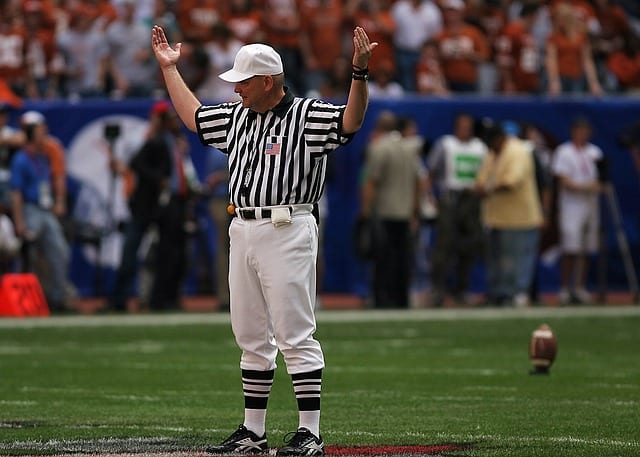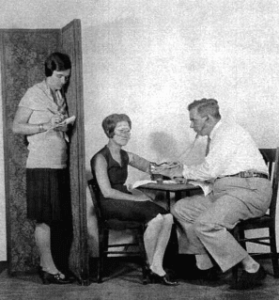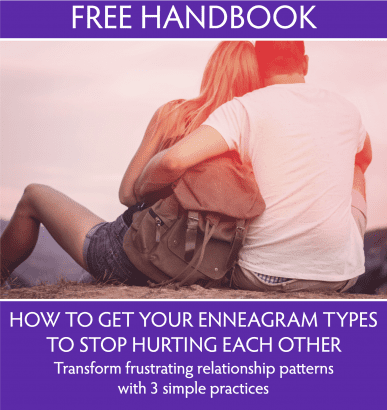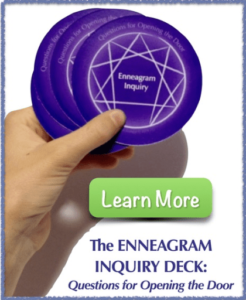One of the greatest temptations in working with our enneatypes is to judge or blame ourselves for having them. This is common, but futile. We all have types and we all have judgments. And we all have something more than either of these.
David Daniels MD holds that acceptance is the most difficult aspect of awareness practice for most people (and most enneatypes). I want to offer you some more depth and texture on this notion today. I will share:
- What we mean by acceptance.
- The three ways I realized judging my type didn’t work.
- How you can orient toward your type in a way that helps instead.
- A simple method to try as an alternative to making what’s happening “good” or “bad.”
“I’m not that kind of person.”
Inwardly and outwardly our type’s qualities can invoke praise or criticism. Each point of view on the wheel has gifts, specialties, and limitations. Trouble comes when we define ourselves by our type qualities: “I am this way,” or “I am not this way.”
Which ways do you tell yourself that you are? That you must be? That you must avoid being?
I’m successful. I’m not creative. I’m creative. I must not be lazy. I’m lazy. I’m a negative person. I’m a positive person. I’m not an ambitious person. I must be generous. I’m scattered. I’m serious. I’m kind. I’m wise. I must not get pinned down. I’m dependable. I’m powerful.
Is Acceptance Agreement?
Acceptance does not mean agreeing either that “I’m wise,” or “I’m not lazy.” Acceptance means noticing that my type patterns show up in me time and again, and acknowledging that this is happening.
I think our souls at some level do reject the notion that our type behavior runs us because type can be experienced as a real constraint. When we’re awake enough, we feel some discomfort or limitation because of the type’s structure and rules. We can accept this too.
But when our inner judge takes up that rejection, it intensifies our feeling of constraint.
Type Is Not Who We Are
When I learned in my twenties that I came from a type Nine perspective on the Enneagram, I had a set of reactions. I felt a validation of my sense of self in a way that felt more complete than others I’d come across before.
I thought, “Oh yeah, I don’t like that self-forgetting aspect of me.” I felt the pain of how I implicitly tell myself I don’t matter. I recognized that my ability to see things from multiple perspectives was automatic and well-developed, etc.
I felt I had gained access to inner X-ray vision. I could see how I was being run, and I had a desire to stop the stuff I didn’t like or didn’t identify with.
What was useful about this orientation was that it pulled me toward being more conscious and laid the groundwork for more true choice in me.
What was not useful about it was the stance I took in it: that there were parts of me that were not-so-good, and that these needed to be changed or improved.
This was not useful for three reasons:
1. My type’s tendencies are not truly parts of me.
Type-based thoughts, emotions and sensations are expressions of patterns or structures in me that I developed to make sense of the world or to adapt to what was valued in my family and culture. They are the leftover forms from a child’s strategy to try to get her needs met.
When I took my Nine-ish tendencies to define what kind of person I was (self-forgetting, compassionate, etc.), I reinforced the setup that most of us live under unconsciously- namely that we can’t be fully present with what’s arising in us because it might fall “out of bounds.”
If, as a Seven for example, I objectively needed some quiet alone time to reflect, my program might tell me “No. You need to seize the day and get busy! There’s so much to do.” In this case, if I stick with who I take myself to be (an up-beat go-getter), I turn away from my true needs in the moment and increase the pressure in the system.
Another reason why trying to fix up my type disappointed was:
2. Trying to make my type “better” strengthens my identification with it.
When I strive to become a more connected Two, a more effective Three, a more authentic Four, a wiser Five, a more secure Six, a more free Seven, a more powerful Eight, a more peaceful Nine, more perfect One, according to the worldview of my type, I am missing the promise of what the map of the Enneagram is pointing to.
Indeed, most of us become interested in inner work because there’s something in our life that doesn’t feel effective about our type- even the aspects of it that we may love about ourselves.
Maybe my Five-ish withdrawal is driving my partner away. Maybe my boss says my Eight-ish straight talk is negatively impacting our team. Maybe I feel sad at Three that my constant work to earn approval from others leaves me feeling sad and alone.
This puts us into a dilemma, but it’s a generative one. At a fundamental level, there’s an imperative to keep up my old world-view, but inner or outer feedback is suggesting that this will cause suffering for me and others.
Because the matrix of type springs from an inaccurate view of who we are and how life is, trying to improve how my type “does its thing” could be seen as wasted energy or misplaced focus.
It’s common to assume that if I just insist on my world view in a stronger or slightly altered way, then I will be safe, or happy, or OK. As seen from a modern perspective, this type of thinking is like someone in a more ancient culture’s resolving to perform more or better livestock sacrifices to keep the gods appeased.
At Six, for example, believing if I just try to be more conscientious, prepared and vigilant, that then I will feel secure is faulty, since more vigilance generally creates more anxiety.
The improve-my-type stance was not useful for a third reason:
3. It set my super-ego against my ego. It set my mind against my mind’s pattern.
To critique my inner psychological structure is a little bit like disparaging my skeleton: “I wish my vertebrae were thinner. I like that my shoulders are broad, but if only my pelvis were tipped forward a bit.”
Whether we are judging “positively” that we’re so energetic, or “negatively” that we’re so “dependent” for example, we are still boxing ourselves up, tightening the grip of our identification with our type structure. This keeps the suffering going whether we happen to feel pleased or despairing in the moment.
As type Four, I might tell myself I’m doing really well not catastrophizing when I’d typically be tempted to do so. Sensing the effect of this directly might feel liberating. But telling myself I’m a “redeemed” Four today, still leaves me on the teeter-totter of potential rejection in the future the next time I do the behavior. Tricky.
Conditional approval and/or rejection of my experience will continue to disconnect me from my essential self.
How Shall We Orient to Type, Then?
While I am all about getting freedom from being run by our types, I am not about damning our types or trying to eradicate them.
I just don’t want my type driving the car.
 Even if I were able to send it to driving school and get it prescription glasses, it is actually not equipped to steer my life as an adult. It was developed as a scaffolding to get me to the place where my mature, present-moment awareness and intelligence could take the wheel.
Even if I were able to send it to driving school and get it prescription glasses, it is actually not equipped to steer my life as an adult. It was developed as a scaffolding to get me to the place where my mature, present-moment awareness and intelligence could take the wheel.
Or maybe we could say, type is more like the car itself, a vehicle within which I move through the world. Understanding that my presence is the driver is what’s important. With this orientation, knowing a lot about my vehicle can help me be able to go where I want to.
Often we either indulge or resist our usual approaches or emotions. Neither of these helps us arrive in the present moment for the magic that life wants us to feel.
It can be tempting to say, as many spiritual traditions have that:
- Ego is bad, and soul is good.
- Judgment is bad, non-judgment is good.
I’d like to offer these reframes as alternatives to consider:
- Ego activity happens; essence is longing to come forth.
- Judgment happens; non-judgment allows me to experience something new.
At type One, making this shift can be particularly challenging, and can also be extremely liberating. One’s world view is based on trying to be right to be OK. Much to the ego’s chagrin, it turns out that the rejection of or the attempt to control the “bad” can backfire- leaving me feeling more driven to correct it, and less content with things as they are. When I learn to accept the pattern and get interested in what else is wanting to emerge, I’m in a new paradigm.
Type’s rules are rigid. True nature is dynamic and alive.
The poet Rumi wrote, “Out beyond ideas of wrongdoing and rightdoing,there is a field. I’ll meet you there.” This is the orientation toward my own precious experience that helps me open up to truth, to being touched, to expanding my sense of self another layer.
So What Can We Do Instead of Identifying With or Judging Our Types?
We can notice the patterns arising in us. We can be ready to “catch ourselves in the act” of approaching life from the automatic platform.
When we do catch it happening, we can take the opportunity to ground, breathe and relax our insistence that this same-old-song is the only possible way to experience life. When we are able to do that, we can open to what else might be interested in coming through us.
For example, a typical inner dialogue with negative self-judgment in the “key” of type Two might go something like this:
“Oh- There I go again flattering the person I’m talking with.Really? Do I really need this clerk’s affection and approval? I must really be desperate. What’s wrong with me?”
In this example, judgment seamlessly takes over my moment of type-awareness. As a result I’ve added more ways to feel good or bad about how I’m acting. I’m not only unconsciously tasked with following my old rules, I’m tasked with following the new rule: to not follow the old rules!
Deliver me!
Trying the inner dialogue again with awareness and presence, dropping the temptation of judgment, it might go something like this:
“Oh! Here’s flattery showing up again. Slipped right out of me without my consent. OK. Let me come back to myself… (a few slow breaths, contacting ground/body sensations)… Mm. Here I am again. What am I sensing right now? I’m still feeling this magnetic pull to make the clerk like me, but I also feel that I’m substantial and exist in my own right, which is enjoyable.”
The second version remains discerning, but not condemning. There is a coming back in to inhabit the self, rather than a looking on as an approving or disapproving parent according to whatever rules we’re measuring ourselves against in the moment.
Your Turn – An Opportunity
Is there a theme you want to pay more attention to in your type pattern? To practice noticing non-judgmentally, I’d recommend choosing one that’s common enough, but that is not highly charged for you.
- Over the next day or days, be on the lookout for the pattern you chose.
- When you catch it happening, invite yourself pause, breathe and notice your body sensations. Depending on the setting and context this can be briefer or longer.
- Once you feel more centered and grounded, you can wonder about the pattern. What was I wanting? How did it feel? How do I feel now? What do I truly want in this moment?
I hope this supports your practice in paying attention to your own unique process. In my experience staying present while avoiding judgment is the gateway to transforming my experience of myself and my life.
I’d love to hear what you noticed- please share in the comments area below. Noticing what gets in the way can be very helpful too.
Here’s to your inner adventure!










2 Responses
I welcome this information you’re sending, Sarah. As a type two, I feel stuck in that needing a connection, so there’s activity of flattering… Most the time, it doesn’t help me.. It only makes me feel more awkward and rejected.
Suzette
Thanks for your reflections Suzette. Next time you notice the experience of the disconnect or the flattering, see whether it’s possible to pause, ground and wonder about it. In tending to your heart in this way, you may find yourself a little closer to offering yourself the presence and connection that you need.